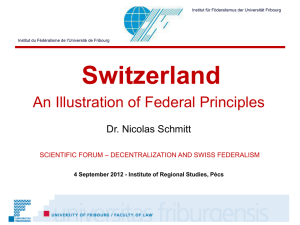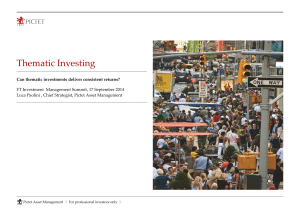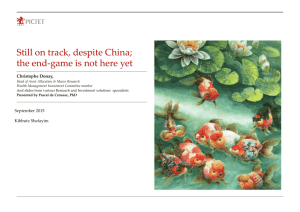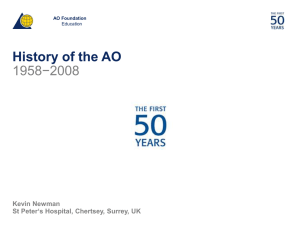Christopher MOURAVIEFF-APOSTOL, Senior Vice
advertisement
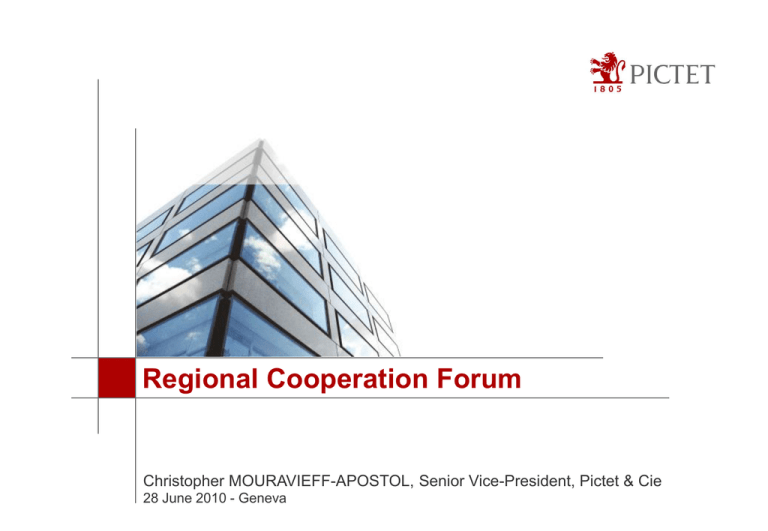
Regional Cooperation Forum Christopher MOURAVIEFF-APOSTOL, Senior Vice-President, Pictet & Cie 28 June 2010 - Geneva Table of Contents 1. Overview of the current Swiss banking environment Wealth Management in Switzerland Current and future challenges (banking secrecy and OECD guidelines) 2. Pictet’s business model 3. Questions 2 Sommaire 1. Overview of the current Swiss banking environment "The greater the difficulty the more glory in surmounting it. Skillful pilots gain their reputation from storms and tempests.“ - Epictetus, Greek philosopher 3 Wealth Management in Switzerland Switzerland is among the world’s leading trio of wealth management centers, alongside the United States and the United Kingdom. The world’s leader in transnational private banking, with a market share of 28% (USD 1880 bio) at end 2009. Switzerland managed the financial and economic crisis very well. Only one of 330 banks needed to be helped by the federal government. This aid was paid back within a year, and thanks to good market conditions, with a benefit for tax payers. Switzerland remains a leading player in the asset management sector. The country‘s banking establishments have continued to see assets grow despite recent pressures. 4 Wealth Management in Switzerland International leadership in wealth management is no coincidence. In a volatile world, location matters : Tradition of high-end services and innovation thanks to availability of skilled and discrete staff Stable and reliable political, regulatory and monetary environment International and intercultural competences necessary in a globalized world Importantly, Switzerland provides wealth management banks that are a pillar of market positioning in an increasingly brand-conscious industry. Merging tradition and entrepreneurial spirit are a winning combination 5 Current and future challenges Pressure on financially weakened states to find new sources of income Sovereign debt crisis. In 2009, Switzerland had a budget surplus, and at 44%, it has one of the lowest levels of debt in the industrialized world. Political pressures on banking secrecy On March 13th 2009, Switzerland announced that it intends to adopt the OECD standards on administrative assistance in tax matters in accordance with Art. 26 of the OECD Model Tax Convention. Within a year, Switzerland has already negotiated 24 DTAs with OECD countries such as the US and as well as most EU member states 6 Current and future challenges Consequences of compliance with OECD guidelines The protection of personal privacy will continue to be upheld for clients not under suspicion. No automatic exchange of information Set up taxes deducted at the source Concentration on developing onshore and transnational wealth management services 7 Current and future challenges Strategic objectives for the Swiss financial center Level playing field OECD 26 should be applied worldwide Competitive tax rates to be incorporated in the agreement on the taxation of savings income Non-discriminatory market access and favourable framework conditions are needed to improve the competitiveness of the Swiss financial centre. 8 Swiss banking system in the current market turbulence Despite the expectation of a recession in 2009, with GDP forecast to shrink by about 3%, we believe that Switzerland should fare better than most developed countries. Its diversified economy, which boasts a strong net external creditor position, thanks to a very high trade surplus, should, in our view, benefit from its focus on value-added products and services. Switzerland has one of the world's highest GDPs per capita and low unemployment, and comparatively low inflation provides continued scope for active monetary policy. - Standard & Poor’s RatingsDirect | May 12, 2009 Strengths: High prosperity of the country, with one of the highest GDPs per capita in the world Stable, diversified, and open economy with low inflation and low unemployment Long-standing political and regulatory stability Leading international wealth-management franchise Strong risk and financial profiles of locally focused institutions Relatively stable funding sources, thanks mainly to strong customer loyalty 9 Sommaire 2. The Pictet business model “Wealth may open the doors to opportunity and choice, but it also brings with it challenges associated with managing diverse (and often intertwined) business and personal assets.” 10 What is a « Banquier privé » What is a private banker ? A private banker is a businessman in the private banking sector, using his own capital to conduct his business, conscious of his unlimited liability and his power to take independent decisions. In Switzerland, the term "private banker" is protected by a collective mark registered with the Federal Institute for Intellectual Property in the name of the Swiss Private Bankers Association since 1997. The use of this mark is reserved for establishments incorporated as sole-ownership companies or as partnerships or limited partnerships. 11 Pictet & Cie Key points Founded in Geneva in 1805, one of Switzerland’s leading private banks Independent Group owned by 7 partners; ownership and management in the same hands; unlimited personal liability of the partners Only organic growth, no acquisitions Core business: wealth management Among the premier independent asset managers in Europe Assets under management and held in custody approaching CHF 404 billion (USD 383 billion), as at 31 March 2010 Investments spread over more than 80 countries 3,000 staff including 600 investment professionals 20 offices worldwide 12 Operating on a worldwide scale Global presence 13 1980-2010: an exceptional period of growth X 40 CHF 404 mia. CHF 66 mia. CHF 8 mia. 900 employees 3000 employees 300 employees 1980 1995 2010 14 Pictet & Cie Organic development centered around clients’ needs WEALTH MANAGEMENT Private Banking Established in 1805 Custody Services Private Clients Established in 1979 ASSET MANAGEMENT Family Office Institutional Asset Management Established in 1998 Established in 1967 Custody Services Institutional Clients Established in 1979 Pictet Funds Established in 1998 15 Pictet and Russia … an ancient relationship 18th century – historical link between the Pictet family and Russia 1761: François-Pierre Pictet, Private advisor to Tsarina Catherine II 1814: Charles Pictet-de-Rochemont, diplomatic envoy for Switzerland to the Congress of Vienna. He secured the recognition of Switzerland’s neutrality with the backing of Tsar Alexander I. 1990’s – pioneer in Russian investments 1994 First Russian Frontier closed-end fund (listed on LSE) 1995 Eastern European Fund (half invested in Russian stocks) Today – comprehensive range of services and products tailored for Russian clients Rubble accounts Deposits in Russian banks Trading in local shares and bonds The Future – a strategic market for Pictet 16 Our Business Model Specialisation and security Focus on one single activity : asset and wealth management Unlimited personal liability : 7 managing partners What is more important still is what we do not do: We do not engage in any form of investment banking and do not issue any commercial, mortgage or unsecured loans As a matter of principle, we do not take participations on our balance sheet. We only have a small trading book for customer facilitation purposes. Most of it is intraday, and total exposure is limited to a small fraction of our equity capital. 17 Pictet’s activities in the recent market turmoil Conservative approach and a simple and straightforward business model: we could go through the financial crisis unhurt. In addition, the partnership model, synonymous of responsibility and accountability, was vindicated. Despite these two difficult years, and to this day, the flow of net new money from both existing and new private and institutional clients accelerated to an unprecedented level, witnessing the trust placed by our clients in our business model. CHF 17 bn in 2008 CHF 20 bn in 2009 18 The future … Our partnership model has been a part of our value proposition throughout our 200 years of history. It means we are a management owned firm, handed down over the years through what is in essence a continuous management buyout. It implies financial responsibility, which generates accountability, upside rewards, but also unlimited downside. It fosters a long term focus, as partners are committed for the long term, avoiding fashions, and learning from the experience of our predecessors through our corporate culture. Finally, it has guaranteed our independence, both in financial terms, but above all, in spirit. - Jacques de Saussure, Managing Partner, Pictet & Cie - 19 Sommaire 3. Your questions 20



